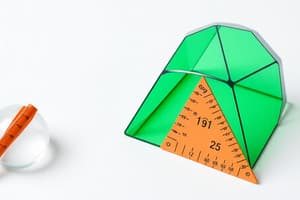Podcast
Questions and Answers
What is the formula for the volume of a sphere?
What is the formula for the volume of a sphere?
- Base area × Height
- πr²h
- alw
- (4/3)πr³ (correct)
What is the formula for the volume of a cylinder?
What is the formula for the volume of a cylinder?
- alw
- Base area × Height
- πr²h (correct)
- (4/3)πr³
What is the formula for the volume of a prism?
What is the formula for the volume of a prism?
- Base area × Height (correct)
- alw
- (4/3)πr³
- πr²h
What is the formula for the volume of a cuboid?
What is the formula for the volume of a cuboid?
How do you find the volume of a composite shape?
How do you find the volume of a composite shape?
What is the length of a cuboid with a base area of 9.5 cm², a height of 8 cm, and a volume of 1292 cm³?
What is the length of a cuboid with a base area of 9.5 cm², a height of 8 cm, and a volume of 1292 cm³?
Study Notes
Volume of Shapes
Cuboid Volumes
A cuboid is a rectangular prism with all edges parallel and opposite edges congruent. The volume of a cuboid is calculated by multiplying the area of the base (a rectangle) by the height (l). In mathematical notation, this can be represented as:
Volume = Base area × Height = alw
For example, if a cuboid has a base area of 9.5 cm², a height of 8 cm, and a volume of 1292 cm³, we can find the length (w) by solving the equation:
1292 = 9.5 × 8 × w
w = 1292 / (9.5 × 8) = 28 cm
Sphere Volumes
The volume of a sphere is given by the formula (4/3)πr³, where r is the radius of the sphere. For example, the volume of a sphere with a radius of 7 cm is (4/3)π(7³) = 336.28 cm³.
Composite Shapes
Composite shapes are made up of two or more regular solids. The volume of a composite shape can be found by adding the volumes of its constituent solids. For example, a composite prism with a base area of 9.5 cm² and a height of 8 cm has a volume of 9.5 × 8 = 76 cm³.
Cylinder Volumes
The volume of a cylinder is given by the formula πr²h, where r is the radius of the base and h is the height of the cylinder. For example, the volume of a cylinder with a base radius of 4 cm and a height of 7 cm is π(4²)7 = 98.21 cm³.
Prism Volumes
The volume of a prism is calculated by multiplying the area of the base (a rectangle) by the height of the prism. In mathematical notation, this can be represented as:
Volume = Base area × Height = alw
For example, if a prism has a base area of 9.5 cm², a height of 8 cm, and a volume of 1292 cm³, we can find the length (w) by solving the equation:
1292 = 9.5 × 8 × w
w = 1292 / (9.5 × 8) = 28 cm
Studying That Suits You
Use AI to generate personalized quizzes and flashcards to suit your learning preferences.
Description
Test your understanding of calculating volumes of different shapes, including cuboids, spheres, composite shapes, cylinders, and prisms. Practice applying formulas and solving problems to find the volume of various shapes.




